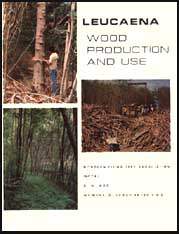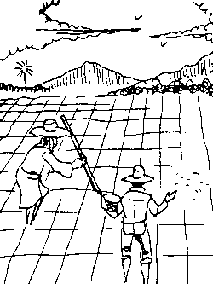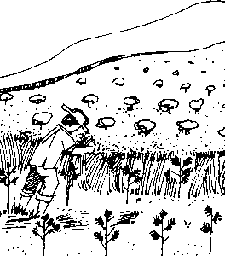9-1 FARMING SYSTEMS
Leucaena can be harvested as frequently as every 4 weeks, or as infrequently as every 10 years for a variety of end uses. This versatility is seen in the farming systems into which it has been integrated, each calling for a different approach to establishment and management. Leucaena grows well in solid stands as a forage or wood crop and can be used in a variety of management systems that allow harvest of both wood and foliage. Among the most important of these to the small farmer are farming systems that also stabilize soils, providing erosion control, fuelwood and green manure. It is in these multiple uses that the crop is best demonstrated and tested for local farm acceptance and economic exploitation.
Leucaena is often planted on farm boundaries, roadsides, and canal and pond banks. It can be planted into marginally productive lands for soil restoration, or for fuelwood-forage uses. Some of these multiple uses are discussed in this chapter.
Soil erosion and degradation is an important problem throughout the tropics. Deforestation, agriculture, grazing, and fire contribute to increased erosion rates which may result in irreplaceable soil and vegetation losses, lowered crop production potential, siltation of rivers and reservoirs, and often irreversible ecological damage. Leucaena has been used as an erosion control species for many years in Southeast Asia (Figure 91).
For erosion control, leucaena can be planted in contour strips of closely spaced trees. Small branches and stems are placed along the contour rows at the base of the stumps when wood or foliage is harvested. Over time, these strips form vegetative terraces which accumulate eroded soil, and can minimize soil loss on steep slopes. Litterfall provides nitrogen and organic matter to help restore soil fertility for crop plants which can be planted between the terraces. Spacing between contour strips depends on the erosion risk of the slope. For steep sites with a high erosion risk, contour rows should be as close as 3m. Contour strips are planted at wider intervals as the risk lessens. Spacing of trees within the contour rows should be 1025 cm. Rows should be managed low enough to encourage development of ground cover.
Planted as a monocrop, leucaena is not an ideal erosion control species, and if left to grow to maturity at high population densities without management, may actually increase erosion rates. This outcome is not likely to occur except in cases where the trees are established on steep slopes and allowed to completely shade the understory vegetation.
Several measures may be used to insure the effectiveness of leucaena based erosion control systems. Grasses, pulses or pasture legumes can be intercropped with leucaena to provide close ground cover. Moderately shade tolerant pulse crops such as Vigna unguiculata (cowpea) provide a number of useful products in addition to their value as cover crops. Centrosema pubescens and Pueraria phaseoloides are examples of climbing cover crops which could be planted into leucaenabased erosion control plantings. Leucaena could also fertilize intercropped grasses, which would provide ground surface protection, although grasses are not generally as shade tolerant as legumes.
9-3 NURSE TREE
Leucaena is an excellent nurse tree which provides light shade, nitrogen and other nutrients to plantation tree crops. It has been used as a nurse crop or support crop for such diverse crops as cacao, coffee, nutmeg, vanilla, black pepper, teak and other species. More research is needed on its use with fast growing fuelwood and pulpwood species such as eucalyptus and gmelina which do not fix nitrogen.
It is common to plant nurse trees on a 5 x 5m to 8 x 8m center, and to trim them periodically. The rapid early growth of leucaena may completely overtake the plantation crop unless the leucaena is trimmed back. Some of the advantages of leucaena use as a nurse tree are:
- It is deeply taprooted, and does not present surface root problems
- Leaflets are fine textured and small in size thus providing lighter shade than larger leafed species. Leaflets also decompose more rapidly after falling
- Arboreal types of leucaena grow vertically with narrow canopies
- Leucaena has few disease and pest problems
- Leucaena thinnings may provide a number of useful end products
9-4 WINDBREAKS AND FIREBREAKS
Leucaena varieties, notably the giants, provide a quick growing windbreak or firebreak. These have been used primarily to protect vegetable and other horticultural operations. Dense, tall leucaena growth is preferred, and is best achieved with multiple row plantings 1-2 m apart. Soil preparation, fertilization, and watering should be optimal to encourage vigorous establishment.
Windbreaks can consist of single rows with trees as closely as 25 cm, but will not achieve the height of more widely spaced trees. Major windbreaks are best made with multiple rows of leucaena together with slower growing trees such as Casuarina spp.
Firebreaks have been found to be effective with 15 to 20 leucaena rows spaced 1-2 m apart. Once established, grass growth under the canopy, which is a major source of fuel, is eliminated. Coppicing of some border row trees may enhance effectiveness of the firebreak by providing a bank of dense green growth at the margins. Loss of leaves during drought or other conditions can make any firebreak more vulnerable, and trees may be burned. However, trees often grow back well from stumps despite fire damage.
- Cut and carry. Harvesting and carrying branches or leaves grown in one area to the planting area, then incorporated into the soil prior to planting or as a side dressing
- Intercropping. Leucaena is grown with other crops on the same piece of land with periodic felling or pruning of the leucaena to provide nutrients available to the intercrop. Also referred to as Alley Cropping.
The nitrogen in leucaena foliage begins to be released to warm, moist soils within 10 days of application. About 50% of the nitrogen in the foliage will be used by the crop, but this percentage is reduced if the foliage is not incorporated into the soil. Nitrogen levels are about 4% in foliage (dry weight basis), or 1% on a fresh weight basis. About half of this is effectively provided to the crop, the rest being lost to the air or leached out of the soil. In order to obtain a yield increase in corn equivalent to 100 kg/ha of ammonium sulfate (20% N. assuming 70% efficiency), one should apply:
- About 3 tons of fresh leucaena per hectare, or
- About 60 gm per corn hill (assuming 50,000 hills per ha.)
9-5 LEAF AS A CO-PRODUCT
Leucaena foliage from tree plantings is a valuable coproduct with several important uses. It is widely known as an animal feed--its use and management for this purpose is fully described in the companion NFTA volume on leucaena animal feed. It is also an excellent green manure and mulch, and has been shown to double yields of corn and cassava. Its suitability as animal ration and green manure in terms of nutrient content and digestibility is presented in Table 9-1.
Table 9-1 Composition of leucaena as percentages of dry matter.
|
Nitrogen |
|
Fiber |
20% |
|
Phosphorus |
|
Ash |
10% |
|
Calcium |
|
Crude Protein |
24-33% |
|
Sulfur |
|
N-Free Extract |
40-44% |
|
Magnesium |
|
Leucaena leaf meal has a rich history as a backyard browse and cut and carry animal feed. Branches from vigorous trees, either in boundary, windbreak or forestry plantings can be pruned and carried to animals. Trees maintained as a shrub or hedge can provide both small diameter firewood and leaf meal products on a sustained use basis.
Leucaena leaf meal is now entering the international market, notably as exports from countries like the Philippines to industrialized Asian nations like Japan and Korea. Although most large scale leucaena forage plantings are mowed frequently from low hedges, it is possible to harvest leaf meal from forest plantations in one of two ways:
- Mechanical. Whole tree chipping operations utilize vacuums to extract leaf and twig waste from chips prior to batching. Similar devices have been proposed by Brewbaker (1980) to extract leaf meal from chipped leucaena prior to burning in a proposed Hawaiian dendrothermal plant.
- Manual. Branches trimmed from harvested leucaena trees may be propped up in the field for 4-7 days until the leaves dry and just begin to fall. Branches are then shaken over mats and leafmeal gathered and sacked. This method has been tested successfully in Malawi for small stemmed Leucaena at rather close spacings.
Organic matter contributions from green manuring can improve soil filth, cation exchange capacity, and water holding capacity. There are two major methods of using leucaena as a fertilizer.
Figure 9-5 Agro-forestry technique for establishment of leucaena with rice and pigeonpeas on good upland sites:
Upland rice, pigeonpeas, and leucaena are direct-seeded at the onset of rains in a weeded, prepared field.
Rice is harvested, leaving leucaena and pigeonpeas behind. Rice straw is applied to soil as a mulch, effectively supressing weeds.
As leucaena grows, pigeonpeas are harvested until they decline and are overtopped. Result is closed leucaena stand, to be grown to economic maturity.
Additional leaf meal can be added after the crop is established to improve grain fill and yield. The foliage also acts as a mulch, shading and cooling the soil, suppressing weeds and reducing moisture losses.
9-6 LEUCAENA IN AGROFORESTRY SYSTEMS.
Besides the green manuring capabilities of leucaena described above, leucaena has many more application in the field of agroforestry. One such system, in wide use in the Philippines, is similar to the tayunga method of forest establishment.
In this management technique, leucaena is planted at the same time as upland crops and allowed to develop slowly underneath. As young plants, leucaena seedlings tolerate competition from well managed agricultural crops (Figure 9-4). Crop harvest releases the small leucaena plants, which rapidly grow and dominate the site. This system has been employed by the Philippine National Electric Administration dendrothermal plantings, and has been shown in several sites to pay for the cost of clearing and establishment.
Leucaena is well suited as a fallow improvement crop in shifting cultivation areas due to its nutrient-rich foliage, rapid regenerative capability and ease of establishment. Leucaena might also be used to recover grasslands for use in shifting cultivation. Grassland areas can be planted to leucaena and allowed to remain in fallow for a number of years before harvesting and planting to food crops. Coppice shoots can be pruned and used as a green manure while the grain or root crop matures, and then left to regrow when crop yields decline or pest problems become severe.



